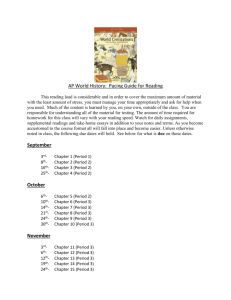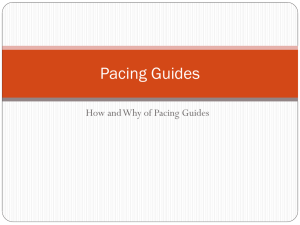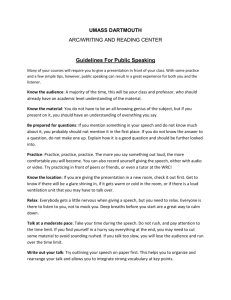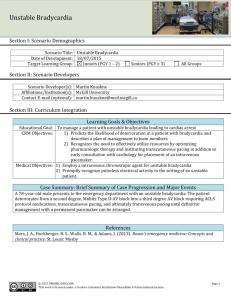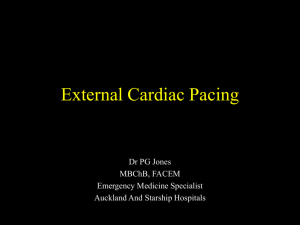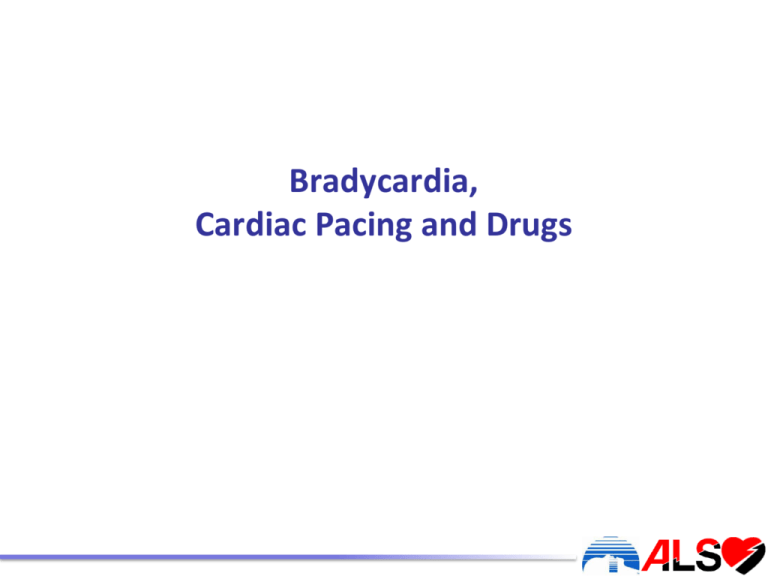
Bradycardia,
Cardiac Pacing and Drugs
Learning outcomes
At the end of this workshop you should:
• Be able to recognise bradycardia and differentiate
•
•
•
•
between the different degrees of heart block
Understand the principles of treating bradycardia
Understand the indications for cardiac pacing
Be aware of the different methods available for
cardiac pacing
Know how to apply non-invasive, transcutaneous
electrical pacing safely and effectively
Conducting system
QRS Complex
How to read a rhythm strip
1. Is there any electrical activity?
How to read a rhythm strip
1. Is there any electrical activity?
2. What is the ventricular (QRS) rate?
3. Is the QRS rhythm regular or irregular?
4. Is the QRS width normal (narrow) or broad?
How to read a rhythm strip
1. Is there any electrical activity?
2. What is the ventricular (QRS) rate?
3. Is the QRS rhythm regular or irregular?
4. Is the QRS width normal (narrow) or broad?
5. Is atrial activity present?
(If so, what is it: P waves? Other atrial activity?)
6. How is atrial activity related to ventricular activity?
Bradycardia
algorithm
Includes rates
inappropriately slow for
haemodynamic state
Interim measures:
•
•
•
•
Atropine 500 - 600 mcg IV
repeat to maximum of 3 mg
Isoprenaline 5 mcg min-1 IV
Adrenaline 2-10 mcg min-1 IV
Alternative drugs *
OR
•
Transcutaneous pacing
Case study
Clinical setting and history
• 60-year-old man referred to admissions unit by GP
• Long-term history of heart disease
• Feeling light-headed and breathless
Clinical course
• ABCDE
- A : Clear
- B : Spontaneous breathing, rate 18 min-1
- C : Looks pale, P 45 min-1, BP 90/50 mmHg, CRT 3 s
Initial rhythm?
- D : Alert, glucose 4.5 mmol l-1
- E : Nil of note
What action will you take?
Case study (continued)
Clinical course
• No response to atropine
• Patient becomes more breathless, cold, clammy and
mildly confused
• Change in rhythm
• ABCDE
- A : Clear
- B : Spontaneous breathing, rate 24 min-1
widespread crackles on auscultation
- C : Looks pale, HR 35 min-1, BP 80/50 mmHg, CRT 4 s
- D : Responding to verbal stimulation
- E : Nil of note
What will you do now?
Case study (continued)
• Consider need for expert help
• Prepare for transcutaneous pacing
• Consider percussion pacing as interim measure
• Confirm electrical capture and mechanical
response once transcutaneous pacing has started
Case study (continued)
Atropine
Indication
• Symptomatic bradycardia
Contraindication
• Do not give to patients who have had a cardiac transplant
Dose
• 500 to 600 mcg IV, repeated every 3 - 5 min to maximum of 3 mg
Actions
• Blocks vagus nerve
• Increases sinus rate
• Increases atrioventricular conduction
Side effects
• Blurred vision, dry mouth, urinary retention
• Confusion
Case study (continued)
Adrenaline
Infusion of 2-10 mcg min-1 titrated to response
OR Isoprenaline infusion 5 mcg min-1 as starting dose
OR Dopamine infusion 2-5 mcg kg-1 min-1
Any questions?
Summary
You should now:
• Be able to recognise bradycardia and differentiate
•
•
•
•
between the different degrees of heart block
Understand the principles of treating bradycardia
Understand the indications for cardiac pacing
Be aware of the different methods available for
cardiac pacing
Know how to apply non-invasive, transcutaneous
electrical pacing safely and effectively
Advanced Life Support Course
Slide set
All rights reserved
© Australian Resuscitation Council and Resuscitation Council (UK) 2010

